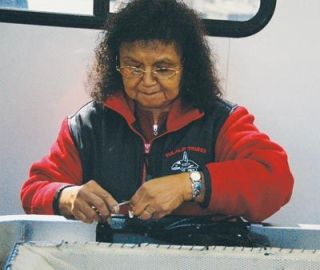TULALIP If youre hooked on Chinook, the Tulalip Tribes have 1.3 million of the prized fish ready to be released this June, but the hatchery-raised salmon wont be ready for a fishing line or dinner plate for many years to come.
And while they are glad to contribute about 11 million juvenile salmon and a small number of trout each year to the western Washington fishery, the Tribes warn that selective recreational fishing might actually hurt the wild runs they and state regulators are trying to rehabilitate.
The fingerlings are raised at the Bernie Kai Kai Gobin Salmon Hatchery to be caught by sport fishermen, and the fish are clipped so they can be identified as a hatchery product. Last week the Tulalips invited local media to see the extensive operation at the hatchery, where Tribal members were clipping the adipose fins from the backs of each fish using two high tech trailers provided by the Northwest Indian Fisheries Commission.
Inside one of the trailers workers were clipping the fins from the back of the fish by hand. Mary Jack was supervising a team of eight to 10 people who stood around a table where the four-inch long Chinooks-in-waiting swam. They were clipped and then pumped back into another pond by large six-inch diameter tubes. Another trailer automatically inserted bits of coded wire for tracking purposes into their jaw before they were trucked to holding pens near Tulalip Bay. Jack said each worker could usually clip 7,000 of the fingerlings per day: the day before the team hit 76,000.
Thats a good count, Jack said.
The workers do this for about 45 to 60 days she said, and proficient clippers can chat while they work.
If you cant talk, just clip, laughed James Scarborough.
As they grow up the absent fin will allow anglers to distinguish them from wild salmon: those are thrown back into the water and only hatchery fish are landed. But Tribal fish biologists warn that rough handling may damage the wild fish just as much. Kit Rawson is a senior official with the Tulalip Fisheries Department and he warned against people landing a wild fish and then posing for pictures or passing the salmon around. That and hooking injuries can damage the fish and introduce disease.
The Tribes stopped catching wild Chinook salmon 20 years ago and now say that 90 percent of the fish they keep are hatchery-reared. Hatchery fish are marked in a couple ways in addition to being clipped: the small metal wires are inserted into their jaws and ear bones are imprinted. Later those can be traced when a fish is the net, helping biologists track the salmonids.
He said throwing back the wild fish might harm them just as much, since many wild fish are usually caught and released for each hatchery salmon kept. Its difficult to determine the mortality rate for those fish, and Rawson suggested that keeping both wild and hatchery fish might help researchers with more complete information. The Tribes agreed to the scheme for its members as long as the state employed the same regulations for non-tribal members too. The Tulalips expressed doubts about the true costs of the plan and will wait to see the results of the impact of the selective fisheries plan.
Meanwhile the Tribes are working on an aggressive plan to restore salmon habitat by breaching the dike surrounding a 360-acre wetland south and west of Sunnyside Boulevard in Marysville. The Qwuloot Marsh restoration project will restore the tidal influence of seawater to the Allen Creek delta and wetlands now protected by tide gates and the dike. The city of Marysville completed a similar restoration on Ebey Slough about 15 years ago, and the Tribes may be breaching the dike later this year. As the seawater reclaims the wetlands in the marsh, more habitat will be created for the food chain salmon depend upon. In addition to the 360 acres of wetland owned by the Tribes, the project will create 5,300 feet of edge habitat, beneficial to fish.
Tribes ready 1.3 million salmon for release in June
TULALIP If youre hooked on Chinook, the Tulalip Tribes have 1.3 million of the prized fish ready to be released this June, but the hatchery-raised salmon wont be ready for a fishing line or dinner plate for many years to come.



